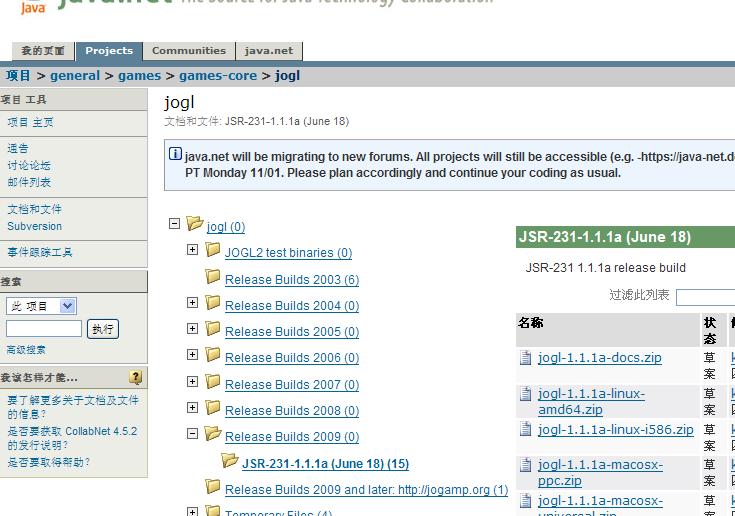JOGL
有许多用Java去结合OpenGL的尝试,但是第一个被大家认可并注意的是Java对于OpenGL的绑定(Java Bindings for OpenGL),或者称为JOGL。
JOGL的背景
为了创建一个图形增强的程序,从而出售给使用各种不同操作系统的用户,程序员有一个选择——OpenGL。GL代表图形库(graphics library)。OpenGL是SGI的注册商标。OpenGL显示它是一个跨平台的C语言编程API。但是事实上,在编程接口上,它是一个与硬件无关的规范。
OpenGL用来制图,速度非常快。大多数情况下,它是硬件加速的。看起来好像OpenGL可以实现一切你想要完成的图形界面。
然而,OpenGL是为C语言而写的。而C语言不是用来编写复杂应用程序的流行语言。而OpenGL一个最大的缺点是:如果不创建一个窗口(用来把图形放在里面),就什么都做不了(当然,这也是OpenGL的最大优点,它独立于具体的操作系统,语言,甚至是硬件)。而OpenGL没有提供创建窗口的方法。如此使得OpenGL对于初学者来说显得比较困难。
因此,有了GLUT(OpenGL Utility ToolKit)。它被用来轻松应对窗口、按钮以及用户事件。但是,对于想要使用面向对象方法编程的程序员来说,学习用C或者C++来编写OpenGL程序仍然不是一件简单的事情。
JOGL
Java也许是最流行的真正的面向对象的编程语言。有许多用Java去尝试结合OpenGL的尝试,但是第一个被大家认可并注意的是Java对于OpenGL的绑定——JOGL。因为它得到Sun和SGI的支持。
OpenGL被用来展示三维模型。它强大、快速,而且可能是自Swing出现以来最棒的一样东西。通过JOGL来使用OpenGL,可以制作出很酷的游戏或者是模型位置等,而在这之前创建它们需要非常昂贵的成本。
JOGL-获取JOGL
就是要找到你操作系统所对应的包,并进行解压。
这个是可以从https://jogl.dev.java.net/找到的,进入网站后点左侧的文档和文件,我下载了Release Builds 2008\JSR-231 1.1.1 - May 22 (15)里面的jogl-1.1.1-windows-i586.zip,解压就得到要的jogl.jar和其他文件了。
这就是你接下来的程序。请确保你输入了所有的代码到你的编辑器中。调试这些程序可以快速地使你明白它们的工作原理。
import java.awt.*;
import java.awt.event.*;
import javax.swing.*;
import net.java.games.jogl.*;
/**
* This is a basic JOGL app. Feel free to
* reuse this code or modify it.
* 这是个基础的JOGL程序,你可以随意重用该代码或者修改它。
*/
public class SecondJoglApp extends JFrame {
public static void main(String[] args) {
final SecondJoglApp app = new SecondJoglApp();
//show what we've done
//看一下我们做了什么
SwingUtilities.invokeLater (
new Runnable() {
public void run() {
app.setVisible(true);
}
}
);
}
public SecondJoglApp() {
//set the JFrame title
//设置JFrame标题
super("Second JOGL Application");
//kill the process when the JFrame is closed
//当JFrame关闭的时候,结束进程
setDefaultCloseOperation(JFrame.EXIT_ON_CLOSE);
//only three JOGL lines of code ... and here they are
//只有三行JOGL代码 ... 如下
GLCapabilities glcaps = new GLCapabilities();
GLCanvas glcanvas =
GLDrawableFactory.getFactory().createGLCanvas(glcaps);
glcanvas.addGLEventListener(new SecondGLEventListener());
//add the GLCanvas just like we would any Component
//像其它组件一样把GLCanvas加入
getContentPane().add(glcanvas, BorderLayout.CENTER);
setSize(500, 300);
//center the JFrame on the screen
//使JFrame显示在屏幕中央
centerWindow(this);
}
public void centerWindow(Component frame) {
Dimension screenSize =
Toolkit.getDefaultToolkit().getScreenSize();
Dimension frameSize = frame.getSize();
if (frameSize.width > screenSize.width )
frameSize.width = screenSize.width;
if (frameSize.height > screenSize.height)
frameSize.height = screenSize.height;
frame.setLocation (
(screenSize.width - frameSize.width ) >> 1,
(screenSize.height - frameSize.height) >> 1
);
}
}
请注意这个类对于第一个类所作的改动。改动只有类名、frame名、以及GLEventListener名。希望你能够阅读代码中的注释,否则你会搞不清它要做什么。
我们实现的GLEventListener确实相对于前面一个例子有了一些改进,它允许我们画出一些漂亮的图来。
import net.java.games.jogl.*;
/**
* For our purposes only two of the GLEventListeners matter.
* Those would be init() and display().
* 为了达到我们的目的,GLEventListener中只有两个方法有用。
* 它们是init()和display()。
*/
public class SecondGLEventListener implements GLEventListener
{
/**
* Take care of initialization here.
* 注意这里的初始化。
*/
public void init(GLDrawable gld) {
GL gl = gld.getGL();
GLU glu = gld.getGLU();
gl.glClearColor(0.0f, 0.0f, 0.0f, 1.0f);
gl.glViewport(0, 0, 500, 300);
gl.glMatrixMode(GL.GL_PROJECTION);
gl.glLoadIdentity();
glu.gluOrtho2D(0.0, 500.0, 0.0, 300.0);
}
/**
* Take care of drawing here.
* 注意这里的绘图。
*/
public void display(GLDrawable drawable) {
float red = 0.0f;
float green = 0.0f;
float blue = 0.0f;
GL gl = drawable.getGL();
gl.glClear(GL.GL_COLOR_BUFFER_BIT);
gl.glPointSize(5.0f);
for (int i=0; i<50; i++) {
red -= .09f;
green -= .12f;
blue -= .15f;
if (red < 0.15) red = 1.0f;
if (green < 0.15) green = 1.0f;
if (blue < 0.15) blue = 1.0f;
gl.glColor3f(red, green, blue);
gl.glBegin(GL.GL_POINTS);
gl.glVertex2i((i*10), 150);
gl.glEnd();
}
}
public void reshape(
GLDrawable drawable,
int x,
int y,
int width,
int height
) {}
public void displayChanged(
GLDrawable drawable,
boolean modeChanged,
boolean deviceChanged
) {}
}
以上就是我们第一个有趣的JOGL程序。下图是输出,有很多好看的颜色。
当 你看到GLEventListener的实现时,可能会感到不知所措。如果你有用C语言编写OpenGL程序的经验的话,你也许能猜测出一些东西。如果你 觉得比较茫然,不必担心,也不要担心我会让你记住这些东西,至少现在不必。本书接下来的篇幅将会对这个例子中的 SecondGLEventListener作出解释。现在,你只需要试着去猜测。试着去修改代码,产生两行,或者一行斜的,而不是一行水平线;或是让所 有的点都变成蓝色或红色。尽情娱乐,这就是你接下来学习JOGL的方式。
这就是你接下来的程序。请确保你输入了所有的代码到你的编辑器中。调试这些程序可以快速地使你明白它们的工作原理。
import java.awt.*;
import java.awt.event.*;
import javax.swing.*;
import net.java.games.jogl.*;
/**
* This is a basic JOGL app. Feel free to
* reuse this code or modify it.
* 这是个基础的JOGL程序,你可以随意重用该代码或者修改它。
*/
public class SecondJoglApp extends JFrame {
public static void main(String[] args) {
final SecondJoglApp app = new SecondJoglApp();
//show what we've done
//看一下我们做了什么
SwingUtilities.invokeLater (
new Runnable() {
public void run() {
app.setVisible(true);
}
}
);
}
public SecondJoglApp() {
//set the JFrame title
//设置JFrame标题
super("Second JOGL Application");
//kill the process when the JFrame is closed
//当JFrame关闭的时候,结束进程
setDefaultCloseOperation(JFrame.EXIT_ON_CLOSE);
//only three JOGL lines of code ... and here they are
//只有三行JOGL代码 ... 如下
GLCapabilities glcaps = new GLCapabilities();
GLCanvas glcanvas =
GLDrawableFactory.getFactory().createGLCanvas(glcaps);
glcanvas.addGLEventListener(new SecondGLEventListener());
//add the GLCanvas just like we would any Component
//像其它组件一样把GLCanvas加入
getContentPane().add(glcanvas, BorderLayout.CENTER);
setSize(500, 300);
//center the JFrame on the screen
//使JFrame显示在屏幕中央
centerWindow(this);
}
public void centerWindow(Component frame) {
Dimension screenSize =
Toolkit.getDefaultToolkit().getScreenSize();
Dimension frameSize = frame.getSize();
if (frameSize.width > screenSize.width )
frameSize.width = screenSize.width;
if (frameSize.height > screenSize.height)
frameSize.height = screenSize.height;
frame.setLocation (
(screenSize.width - frameSize.width ) >> 1,
(screenSize.height - frameSize.height) >> 1
);
}
}
请注意这个类对于第一个类所作的改动。改动只有类名、frame名、以及GLEventListener名。希望你能够阅读代码中的注释,否则你会搞不清它要做什么。
我们实现的GLEventListener确实相对于前面一个例子有了一些改进,它允许我们画出一些漂亮的图来。
import net.java.games.jogl.*;
/**
* For our purposes only two of the GLEventListeners matter.
* Those would be init() and display().
* 为了达到我们的目的,GLEventListener中只有两个方法有用。
* 它们是init()和display()。
*/
public class SecondGLEventListener implements GLEventListener
{
/**
* Take care of initialization here.
* 注意这里的初始化。
*/
public void init(GLDrawable gld) {
GL gl = gld.getGL();
GLU glu = gld.getGLU();
gl.glClearColor(0.0f, 0.0f, 0.0f, 1.0f);
gl.glViewport(0, 0, 500, 300);
gl.glMatrixMode(GL.GL_PROJECTION);
gl.glLoadIdentity();
glu.gluOrtho2D(0.0, 500.0, 0.0, 300.0);
}
/**
* Take care of drawing here.
* 注意这里的绘图。
*/
public void display(GLDrawable drawable) {
float red = 0.0f;
float green = 0.0f;
float blue = 0.0f;
GL gl = drawable.getGL();
gl.glClear(GL.GL_COLOR_BUFFER_BIT);
gl.glPointSize(5.0f);
for (int i=0; i<50; i++) {
red -= .09f;
green -= .12f;
blue -= .15f;
if (red < 0.15) red = 1.0f;
if (green < 0.15) green = 1.0f;
if (blue < 0.15) blue = 1.0f;
gl.glColor3f(red, green, blue);
gl.glBegin(GL.GL_POINTS);
gl.glVertex2i((i*10), 150);
gl.glEnd();
}
}
public void reshape(
GLDrawable drawable,
int x,
int y,
int width,
int height
) {}
public void displayChanged(
GLDrawable drawable,
boolean modeChanged,
boolean deviceChanged
) {}
}
以上就是我们第一个有趣的JOGL程序。下图是输出,有很多好看的颜色。
当 你看到GLEventListener的实现时,可能会感到不知所措。如果你有用C语言编写OpenGL程序的经验的话,你也许能猜测出一些东西。如果你 觉得比较茫然,不必担心,也不要担心我会让你记住这些东西,至少现在不必。本书接下来的篇幅将会对这个例子中的 SecondGLEventListener作出解释。现在,你只需要试着去猜测。试着去修改代码,产生两行,或者一行斜的,而不是一行水平线;或是让所 有的点都变成蓝色或红色。尽情娱乐,这就是你接下来学习JOGL的方式。





【推荐】国内首个AI IDE,深度理解中文开发场景,立即下载体验Trae
【推荐】编程新体验,更懂你的AI,立即体验豆包MarsCode编程助手
【推荐】抖音旗下AI助手豆包,你的智能百科全书,全免费不限次数
【推荐】轻量又高性能的 SSH 工具 IShell:AI 加持,快人一步
· 如何编写易于单元测试的代码
· 10年+ .NET Coder 心语,封装的思维:从隐藏、稳定开始理解其本质意义
· .NET Core 中如何实现缓存的预热?
· 从 HTTP 原因短语缺失研究 HTTP/2 和 HTTP/3 的设计差异
· AI与.NET技术实操系列:向量存储与相似性搜索在 .NET 中的实现
· 周边上新:园子的第一款马克杯温暖上架
· Open-Sora 2.0 重磅开源!
· .NET周刊【3月第1期 2025-03-02】
· 分享 3 个 .NET 开源的文件压缩处理库,助力快速实现文件压缩解压功能!
· Ollama——大语言模型本地部署的极速利器